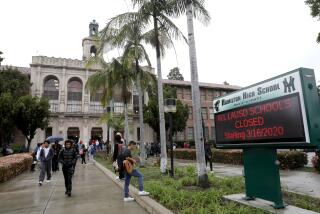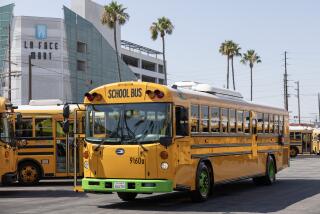Portable Classrooms Snag Plan for Schools : Education: A lack of bungalows may eliminate an option for elementary schools. That may force adoption of the more controversial year-round schedule to create space.
- Share via
After months of protracted, often acrimonious debate, Los Angeles Unified School District board members last month thought they had finally wrestled the district’s most intractable problem to the ground.
By a narrow margin, board members voted to contain the overcrowding that has crippled the district by putting all 600 of its schools on a year-round schedule next year, and requiring each of them to accommodate 23% more students.
But the plan has been snagged by tactical problems that the board must try to untangle today, when it decides how to implement its overcrowding relief plan in the 109 elementary schools that will be the first to increase their capacities this year.
Last month, those schools were told they could choose from among three options to increase their seating capacity: They could put two more children in each class, add bungalow classrooms or convert to multi-track, year-round operation, which puts groups of students at a school on staggered attendance schedules that run throughout the year.
But the board also has voted to restrict those options by not allowing a school to use portable classrooms to push its enrollment beyond 1,000 students. That means, in effect, that 63 of those 109 schools may have no choice but to go to the multi-track, year-round plan, which many parents oppose as disruptive to families.
In addition, 25 other schools that would likely have opted for portable classrooms may be forced to go year-round instead because bungalows will not be available this year.
The dilemma of how to provide schools with as much choice as possible while fairly spreading the burden of relieving overcrowding has resurrected the deep divisions among school board members and alarmed parents, who thought the issue was settled with last month’s vote.
“You think you have options, then the next thing you hear is you really don’t have a choice,” said Cathy Fisher, a parent at Dixie Canyon Elementary School in Sherman Oaks. “It’s all kind of confusing. I think lots of parents are just holding their breaths.”
Dixie Canyon is on the list to increase its capacity this year, and parents and teachers would very likely have chosen to increase class size and use bungalows when the vote is held on the options next month.
But those bungalows would not arrive until July, 1991, and the school board is now locked in debate over whether schools like Dixie Canyon should be allowed to wait a year, until they get their bungalows, or be forced to use the only remaining option to increase capacity--a multi-track, year-round schedule.
To many parents who were counting on using bungalows to avoid going multi-track, year-round this year, the news that the board may not allow them the leeway to acquire the portable classrooms has been a disappointing blow.
“We’re trying to be optimistic, but a lot of parents are looking at private schools, just in case,” Fisher said. “Our time is running out to make decisions for next semester, and we still don’t know where we stand.”
District officials say it would cost between $7.5 million and $10 million to supply 100 portable classrooms to the schools expected to request them this year, and it would take up to 18 months to get the bungalows on campus because of the time-consuming state review process and the building alterations that would have to be made at some schools.
The money would come from the district’s $80-million developer fee account, which can only be used for portable classrooms or construction to relieve school overcrowding.
More than half of that money is already committed to school building projects, and some board members question whether it is wise to spend so much on portable classrooms in a district that desperately needs new schools and find it increasingly difficult to get the state to pick up the tab.
And, finances aside, board representatives from some of the district’s most crowded areas say they oppose allowing some schools to wait a year, calling that unfair to the 63 campuses that have no choice but to adopt multi-track year-round schedules because they are already too large or don’t have enough playground space for portable classrooms.
“I’m pained by this whole idea that 63 schools have no choice,” East Los Angeles board representative Leticia Quezada said at last week’s board meeting. “If we’re going to give 63 schools no choice because they have no space . . . that ought to apply to all 109 schools and not just to some.”
Quezada accused the district of being “tremendously accommodating” to those schools--mostly on the Westside and in the San Fernando Valley--that want portable classrooms, and “patently unfair” to the most-overcrowded schools.
And South-Central Los Angeles representative Rita Walters--who voted against the year-round plan--blasted her colleagues for leaving a “huge loophole” that could allow many schools to escape the capacity increase requirement this year.
“Again, all the choices accrue to those people in those schools that are not overcrowded,” she said.
Walters has threatened to urge schools on the list in her district to refuse to adopt multi-track, year-round schedules if other schools that want--but cannot get--portable classrooms are not forced into multi-track operation this year.
But district officials say allowing the schools that request portable classrooms to wait a year would not hamper the overcrowding relief plan, and a majority of the board seems inclined to agree to the delay when it votes at today’s meeting.
By waiting, the district would lose about 3,000 of the 21,000 seats the plan was expected to create at elementary schools this year, according to Gordon Wohlers, whose office devised the overcrowding relief plan. That would not pose a problem unless far more than the expected 11,000 new elementary students show up to enroll next fall, he said.
But some board members fear that letting certain schools on this year’s list wait a year to generate more seats is likely to compound the problem of adding space next year, when another 100 schools must find ways to increase their capacities.
Over the next three years, all the district’s schools are mandated to increase space for students by 23%. Many of those schools will want to rely on portable classrooms to ease overcrowding rather than the more controversial multi-track, year-round schedule.
The district generally spends between 10% and 15% of the more than $40 million it collects each year in developer fees on portable classrooms. That is far short of the $10 million or so it would take each year to keep up with the expected demand for the bungalows.
Because money is so tight, the board is hard-pressed to find other ways to deal with the district’s overcrowding crisis, which results in more than 20,000 children being bused away from their neighborhood schools each day, at a cost of $2.8 million a year.
Today, the board will examine another method of creating more seats when they vote on whether to consider relaxing the district’s integration guidelines at 126 schools that are more than one-third white, in order to find more space for minority students from overcrowded schools.
Although the district’s goal is to maintain integrated schools--with no more than 60% minority enrollment--its growing proportion of minority students and the need to find space for them outside their neighborhood schools have combined to force changes in those integration guidelines at most of the district’s 600 schools.
The changes to be proposed today would allow district staff to study whether 72 magnet schools and 54 other schools that serve as receivers for children bused from overcrowded areas could accommodate up to 70% minority students without leading to segregation.
Those schools are the only remaining campuses in the district that still adhere to the 60% minority limit. As the district has become more than 85% minority, schools have been studied and switched to the 70/30 integration ratio to accommodate growing minority enrollment.
The changes would allow more minority students to attend magnet schools.
NEXT STEP
The Los Angeles Unified School District has been struggling for years to find ways to accommodate its fast-growing enrollment. This month, public meetings will be held at elementary schools that must increase student capacity this year. In April, parents, teachers and staffs of those schools will vote on individual school plans to reduce overcrowding. Over the next three years, all district schools will follow this process to increase capacity.
More to Read
Sign up for Essential California
The most important California stories and recommendations in your inbox every morning.
You may occasionally receive promotional content from the Los Angeles Times.










